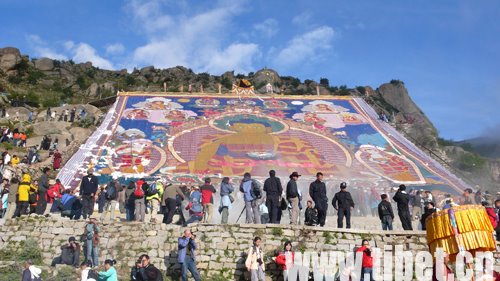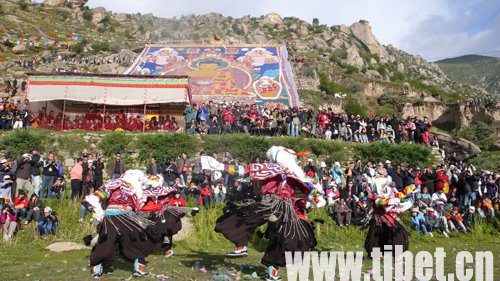

【中国官媒报道“雪顿节展佛仪式在哲蚌寺隆重举行”http://info.tibet.cn/news/xzxw/whhb/200808/t20080830_423277.htm】
说是,拉萨今天在热烈地过“雪顿节”。
去拉萨旅游的朋友说,上午去哲蚌寺看晒大佛了,10点钟开始,12点钟结束。
问他去的人多不,他说多呢,好多藏民呢。问他抬唐卡的是什么人,他说反正是穿红衣服的人。
当然,他们——了不起的导演们,会在拉萨上演“雪顿”这场戏的。
哲蚌寺、色拉寺、甘丹寺的僧人们,已经抓了一千多,剩下不多的僧人们只能不得不出来“晒大佛”了。寺管会的命令谁敢不听从?不去?不去的话,武警和公安就会扭送到格尔木的“关塔拉摩”那。
绕木齐、冲赛康、嘎玛衮桑那一片片藏人聚居区,被抓走的藏人有多少?胆颤心惊的藏人们只能不得不出来过“雪顿”了。居委会的命令谁敢不听从?不去?不去的话,每年200元的肉食补贴立即取消。
3·14以后,只要外国媒体来访,退休干部、在职干部就会被派到寺院,假装朝佛的信徒,围着佛像转啊转。不去?不去的话,退休金取消,公职开除。等外国记者走了,那就不准再去寺院了。再去?退休金取消,公职开除。
呵呵,今天,挤挤攘攘地去哲蚌、色拉看晒大佛的人们;今天,挤挤攘攘地去罗布林卡看“拉姆”的人们,假啊假,假作真时真亦假,什么都是假的,连心也是假的,只有泪水是真的,泪往心里流。
呵呵,动作真够快的,新华社的消息已经出来了,说拉萨人民“喜迎雪顿节”呢。中国西藏信息中心的照片也出来了,去年展佛时勒令取消的藏戏,今年展佛时又变魔术般的出现了,竟然厚颜声称是“传统仪式”,真健忘啊,怎么去年就不继承“传统”呢?
有人说:今日中国——“小康小康是假,宗教宗教是假,改革改革是假,开放开放是假,发展发展是假”,我得说:今日拉萨——雪顿雪顿是假!和谐和谐是假!
2008-8-30
附一篇写去年“雪顿”的文章:
今年“雪顿”不正常
文/ 唯色
8 月12日上午,巨大的释迦牟尼佛像唐卡在拉萨著名的哲蚌寺迟迟展出,数万信徒和中外游客在场,许多藏人已察觉出与往年相比很异常。而官方媒体的报道却是一 片赞美盛世佳节的欢声,并用张张绚丽的图片烘托气氛。不过细看图片,抬唐卡上山和展示唐卡的大多是穿俗装的普通人,传统上,承担这些事务的必是数百名穿袈 裟的僧侣。
哲蚌寺展佛是西藏重要的宗教节日——“雪顿”的序幕。从1642年起,每年藏历6月30日,拉萨百姓会前往哲蚌寺,向恪守戒律 的僧人奉献酸奶,附近各地擅长藏戏的民众也会带上面具和彩衣赶来演出。随着藏戏鼓点急促响起,寺院僧侣会在法号和诵经声中举行盛大法会,并从大殿中抬出锦 缎绣制的巨幅唐卡,在旭日照耀的山坡上展开,慰藉众生心灵。随后,各地藏戏演员会在达赖喇嘛的夏宫——罗布林卡演出多日,以示隆重的供奉。这个从相互施舍 中得到快乐的节日,在上世纪六七十年代,被毛泽东发动的运动中断多年。
如今的西藏虽又恢复诸多的传统节日,但在同一个政权的控制之 下,往往徒有虚名。原本严格的传承、固定的时间和完整的程序,随时被要求根据形势的变化增添、删减或调整,得不到丝毫尊重。如近年来,在商业化的冲击 下,“雪顿”这个宗教节日已演变为商业节日,当局的口号是“文化搭台,经贸唱戏”,实则是“宗教搭台,经贸唱戏”,神圣的展佛则成了吸引“招商引资”和标 榜信仰自由的表演节目。
而今年“雪顿”所遭到的打击可谓文革之后最严重。“雪顿”前夕,当局勒令取消展佛之前的藏戏演出,理由是场地 小,人太多,担心发生意外。这个决定震惊了哲蚌寺,僧侣们表示如果取消传统藏戏,那么“雪顿”就不成其为“雪顿”了;更有喇嘛大胆直言:这些年来,西藏的 宗教活动一个个被取缔,西藏的宗教权利一项项被剥夺,而我们已经不得不放弃了“默朗钦莫”(藏历新年的祈愿大法会)、“江央贡却”(冬季辨经大法会),现 在又要在展佛时放弃“拉姆”(藏戏),这是再也不能服从的。于是僧人们采取的对策是拒不参加展佛。
按惯例,展佛时间应是太阳初升之 时,当众僧把巨幅唐卡缓缓展开,金色阳光恰好照耀在美丽的佛颜上,显得无比辉煌。如此壮美景象,我曾几次目睹,深受震撼。如此壮美景象,穿绛红袈裟的众僧 绝对是其中一部分,不可缺少也不可替代。所以当太阳升起良久,等候展佛的信众和游客布满哲蚌寺的后山,而僧人们集体闭门不出,令当局有关部门大为恼怒。据 说后来是在软硬兼施之下,才有十多名僧人与一群维持秩序的保安人员,匆匆地从大殿里抬出了唐卡,并在没有藏戏演出也没有专门法会的情形下,匆匆地在山崖上 展开了唐卡。哲蚌寺的一位喇嘛对我说:“像这样没有举行任何仪式的展佛,从无先例。”
(RFA藏语专题节目)
2007-9-4
转贴RFA的英文报道:
Tibetan Monks Still Held in Qinghai
RFA[Friday, August 29, 2008 15:54]
Months after widespread Tibetan protests against Chinese rule, hundreds of monks are detained in Qinghai.
LHASA,
Tibet: Chinese policeman keeps watch on crowd as Tibetan Buddhist monks
chant prayers at Drepung monastery, August 2003. (Photo: AFP)
KATHMANDU
— Hundreds of Tibetan monks detained after widespread protests against
Chinese rule earlier this year were deported from the Tibetan capital
Lhasa to remote Qinghai province, where they remain in custody,
according to Tibetan sources.
Monks from two major Tibetan Buddhist monasteries, Sera and Drepung, both in the Tibet Autonomous Region (TAR), may have been targeted because they were seen as playing a leading role in the demonstrations, the sources said.
Many came to study at the two monasteries near Lhasa from remote areas in eastern Tibet where the Kham and Amdo dialects are spoken.
A smaller group of monks was removed from another monastery, Ganden, and taken into detention with the others, the sources said, speaking on condition of anonymity.
Unrest erupted in Lhasa on March 14 after four days of peaceful protests, turning into a day of riots targeting Han Chinese residents and businesses. China reacted by sending in a large force of paramilitary People’s Armed Police to quell the unrest, sealing off the TAR and Tibetan-populated regions of China from contact with the outside world.
Exiled Tibetan leaders say 203 people died in the violence that followed, while Beijing says 22 people died, only one of them Tibetan.
Train from Lhasa
According to an authoritative source who spoke on condition of anonymity, 675 Tibetan monks from the three targeted monasteries were put on a train from Lhasa on April 25.
“Among those 675 monks, 405 were from Drepung, 205 were from Sera, and eight were from Ganden,” the source said. The remaining 57 monks from outlying areas were said to have been taken from smaller Lhasa monasteries.
“They were transported to a military detention center in Golmud” in the Haixi [in Tibetan, Tsonub] Mongol and Tibetan Autonomous Prefecture in Qinghai, the source said.
“All the monks who came originally from the Qinghai region were [then] deported to their respective towns. They are still detained there in their hometown prisons or detention centers.”
They were escorted home from Golmud by officials from the Qinghai United Front and Religious Affairs Bureau, according to the source.
Monks who came originally from monasteries in the still-troubled region of Kham in Sichuan province are still being held in Golmud, however, the source said. The number of those still in detention cannot be independently confirmed.
Three groups
The monks were rounded up in three groups, the source said.
“On April 10 in the afternoon, security forces detained 550 monks from Drepung monastery, took them to the Nyethang Military School, and detained them on the school campus.”
“Then, on the night of April 14, a huge contingent of Chinese security forces arrived at Sera monastery and took away about 400 monks and detained them at a military prison in Tsal Gungthang,” about 20 kms (12 miles) east of Lhasa, the source said.
“On April 17, a group of monks from Ganden was also rounded up and detained somewhere in Lhasa,” the source added.
All those detained were reported to have suffered harsh treatment, including beatings, while in prison.
“Twenty-four monks from Drepung and Sera monasteries remain in detention at the Nationalities Middle School in the Marpa subdivision of Rebgong in Qinghai province, where they have been held since July 25” after being moved from Lhasa in April, the source said.
Held in a house
Another source with contacts in the region said that a small group of monks from monasteries in Sogpo county in the Malho [in Chinese, Huangnan] Tibetan Autonomous Prefecture of Qinghai had been studying in Lhasa monasteries at the time of the unrest.
“Recently, they were found detained in a house close to the Sogpo county center,” he said. “They had not been put into prisons but were under some kind of house arrest. Later, we learned that they had been taken into detention in Golmud in April.”
“They are not allowed to leave, but their family members and relatives can see them at the house where they are being held.”
“There were about 30 to 40 monks studying in Lhasa who had come from different monasteries in Gepasumdo [in Chinese, Tongde] county” in the Tsolho [in Chinese, Hainan] Tibetan Autonomous Prefecture in Qinghai, the source said.
“There were 20 monks from Tsang monastery alone who were studying at Sera. We were told that all of them were detained.”
Brother held
A Tibetan woman living in Rebgong [in Chinese, Tongren] county in the Malho Prefecture said she had learned that her brother, a monk studying in Lhasa, had been taken to the Golmud City Detention Center.
“As you know, he was from Kirti monastery in Aba [in Tibetan, Ngaba] Prefecture [in Sichuan], but was at Sera monastery in Lhasa at the time of the March protests,” she said. “We couldn’t trace him for a long time.”
Lhasa monasteries generally take in many monks from outlying areas, including Qinghai province. “That’s always been the case, historically,” Tibet expert Robbie Barnett, based at Columbia University in New York, said.
These monasteries “have colleges that are specifically designed, and have been for centuries, to accommodate people from those areas,” he added. Efforts beginning in 1994 to stop this practice have largely proven unsuccessful, Barnett said.
Barnett cited reports that the Lhasa protests that began March 10 comprised monks from the Amdo Tibetan area in Qinghai province.
“Some people have said that this was quite definitely the case. And some people have said that this was also true of the Sera and Drepung [demonstrations] on the other two days,” he said, but added:
“I don’t know how strong the evidence is for that.”
Contacted by Radio Free Asia, officials at the Sera Monastery Management Committee hung up the phone, while officials at the Drepung Monastery Management Committee refused to speak to RFA reporters.
Officials at the Huangnan Prefecture Public Security Bureau denied knowledge of any monks being held at the Nationalities Middle School in Rebgong.
Original reporting by RFA’s Tibetan service. Translations by Karma Dorjee. Tibetan service director: Jigme Ngapo. Written and produced in English by Sarah Jackson-Han. Edited by Luisetta Mudie and Richard Finney.